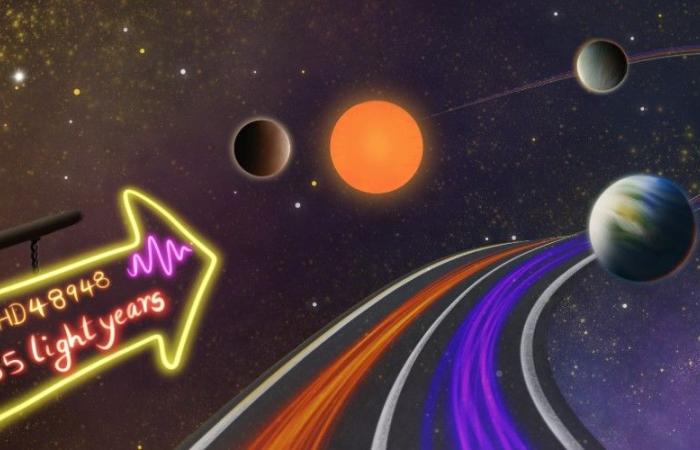Spot three potential super-Earths orbiting an orange dwarf star relatively close to us. Signing the discovery, published today on Monthly Notices of the Royal Astronomical Societya team led by Shweta Dalal from the University of Exeter (UK).
The three exoplanet candidates orbit the star Hd 48948, located about 55 light years from Earth, taking 7, 38 and 151 Earth days respectively, and have minimum masses ranging from 5 to 11 times that of Earth. Worthy of particular interest is Hd 48948 d, the outermost exoplanet candidate: it resides in the habitable zone of its host star, where conditions could allow the existence of liquid water. The team suggests that the proximity of the star, combined with the favorable orbit of the outermost planet, makes this system a promising target for future studies of imaging direct high contrast and high resolution spectroscopy.
Artist’s impression of the planetary system HD 48948, which is located at a distance of 55 light years from Earth. The Voyager 1 probe, at its current speed, would take almost a million years to reach HD 48948. Credit: Soumita Samanta (www.soumitasamanta.com)
“Among those with a star similar to the Sun, this is the closest planetary system to us in which there is a super-Earth in the habitable zone,” he tells Average Inaf one of the authors of the study, the astronomer Luca Malavolta of the University of Padua, recalling that «the discovery is the result of years of observations at the Galileo National Telescope (Tng) with the Harps-N spectrograph, one of the most precise exoplanet hunters in the world».
Using Harps-N, the team collected nearly 190 high-precision radial velocity measurements over a decade. Radial velocity measurements, tracking the tiny movements of the star caused by planets orbiting it, are crucial to these discoveries. By analyzing the spectrum of the star’s light, researchers can determine whether it is moving towards us (blueshift) or far from us (redshift), thus going back to the number, period of revolution and mass of the planets present in the system. To ensure the accuracy of the discovery, the team resorted to different methodologies and comparative analyses.
These three potential super-Earths – that is, planets with a mass greater than that of Earth but significantly less than that of the Solar System’s ice giants, Uranus and Neptune – were identified, in particular, as part of the Harps-N “Rocky Planet Search”. The discovery now opens up new possibilities for understanding planetary systems and for searching for the presence of life beyond the Solar System.
“This discovery highlights the importance of long-term monitoring and advanced techniques for uncovering the secrets of distant star systems,” Dalal emphasizes. “We are eager to continue our observations and search for other planets in the system.” And having identified “a super-Earth in the habitable zone around an orange star”, concludes the researcher, “is an exciting step forward in our search for habitable planets around solar-type stars”.
To know more:
- Read on Monthly Notices of the Royal Astronomical Society the article “Trio of super-Earth candidates orbiting K-dwarf HD 48948: a new habitable zone candidate”, by S Dalal, F Rescigno, M Cretignier, A Anna John, FZ Majidi, L Malavolta, A Mortier, M Pinamonti, LA Buchhave, RD Haywood, A Sozzetti, A Ghedina, A Harutyunyan, DW Latham, M López-Morales, C Lovis, AF Martínez Fiorenzano, M Mayor, B Nicholson, F Pepe, M Stalport, S Udry, CA Watson and TG Wilson
Correction dated 06/25/2024: the name of the star is Hd 48948, and not Ho 48498 as initially reported.






